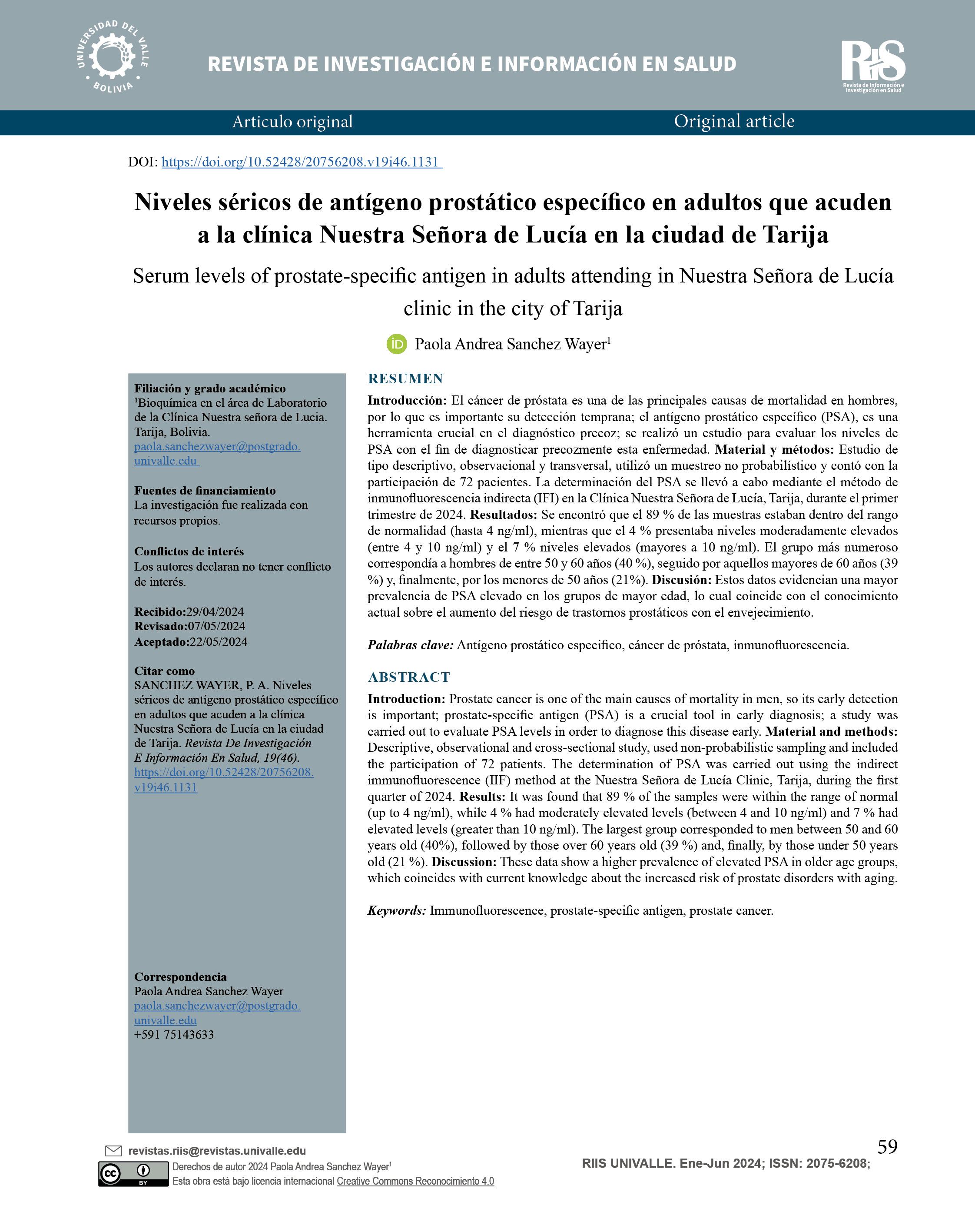Serum levels of prostate-specific antigen in adults attending the Nuestra Señora de Lucía Clinic in the City of Tarija
DOI:
https://doi.org/10.52428/20756208.v19i46.1131Keywords:
AntigensAbstract
Objective: Prostate-Specific Antigen (PSA) for early diagnosis of prostate problems in patients attending Nuestra Señora de Lucia Clinic, in the Department of Tarija, in the first quarter of 2024.
Material and Methods: This is a descriptive, observational, cross-sectional study, with non-probabilistic sampling, with a total of 72 participants attending Nuestra Señora de Lucia Clinic in the department of Tarija. PSA determination was performed using the IFI method.
Results: A total of 72 samples from male patients were analyzed for prostate-specific antigen (PSA) determination. It was found that 89% of the samples were within the normal range (up to 4 ng/ml), while 4% had moderately elevated levels (between 4 and 10 ng/ml) and 7% had elevated levels (greater than 10 ng/ml). Regarding age distribution, it was observed that the most attended group was in the 50 to 60 years range, representing 40% of the sample. This was followed by patients aged 60 years or older, with 39%, and those under 50 years old, with 21%.
Downloads
References
Camus AG, Sordo JCV. LA PRÓSTATA: ESTRUCTURA, FUNCIÓN Y PATOLOGÍA ASOCIADA MÁS FRECUENTE. 2016.
Hermabessière J, Taillandier J. Fisiología de la próstata. EMC - Urol. 1 de enero de 2002;34(1):1-6.
https://doi.org/10.1016/S1761-3310(02)72340-2 DOI: https://doi.org/10.1016/S1761-3310(02)72340-2
Angulo JC, Viñas MA, Gimbernat H, Fata FR de, Granados R, Luján M. El PSA basal en una población de varones españoles de 40-49 años anticipa la detección de cáncer de próstata. Actas Urol Esp. 1 de diciembre de 2015;39(10):605-11.
https://doi.org/10.1016/j.acuro.2015.05.003 DOI: https://doi.org/10.1016/j.acuro.2015.05.003
PMid:26099906
Panach-Navarrete J, Gironés-Montagud A, Sánchez-Cano E, Doménech-Pérez C, Martínez-Jabaloyas JM. Uso del antígeno prostático específico en atención primaria (PSA). SEMERGEN - Med Fam. 1 de abril de 2017;43(3):189-95.
https://doi.org/10.1016/j.semerg.2016.04.023 DOI: https://doi.org/10.1016/j.semerg.2016.04.023
PMid:27344583
Rocio BQR. PACIENTES ATENDIDOS DEL SERVICIO DE UROLOGÍA - HOSPITAL MILITAR CENTRAL. 2022;48.
Patiño LB, Ysasis LA. Antígeno Prostático Especí co como marcador tumoral. 2008;12.
ANTIGENO PROSTATICO ESPECIFICO SU PAPEL EN EL DIAGNOSTICO DE CANCER DE PROSTATA [Internet]. [citado 25 de octubre de 2023]. Disponible en: https://www.redalyc.org/pdf/4577/457745488001.pdf
Delgado DD. CÁNCER DE PRÓSTATA: ETIOLOGÍA, DIAGNÓSTICO Y TRATAMIENTO. 2016;4.
Hernandez C, Morote J, Miñana B, Cozar JM. Papel del antígeno prostático específico ante las nuevas evidencias científicas. Actas Urol Esp. 2013;37(6):324-9. https://doi.org/10.1016/j.acuro.2013.01.009 DOI: https://doi.org/10.1016/j.acuro.2013.01.009
PMid:23608183
Silva IBP, Sardain EB. © ORGANISMO ANDINO DE SALUD - CONVENIO HIPÓLITO UNANUE. 2022;1:133.
Salcedo PO, Enríquez RS, Huahuamullo JC, Ortiz LS. Utilidad del PSA (Antígeno Prostático Específico) total como método de tamizaje para diagnóstico de hipertrofia de próstata y cáncer prostático, Hospital Obrero No 1, febrero-mayo del 2009, Bolivia. 2011;
Garcia K, Serna Y. Relación entre los niveles de antígeno prostático específico y diámetro prostático en pacientes con cáncer de próstata del hospital Augusto Hernández Mendoza, Ica 2019-2020 [Internet]. [Perú]; 2022 [citado 25 de octubre de 2023]. Disponible en: https://repositorio.continental.edu.pe/handle/20.500.12394/12377

Published
How to Cite
Issue
Section
License
Copyright (c) 2024 PAOLA ANDREA SANCHEZ WAYER

This work is licensed under a Creative Commons Attribution 4.0 International License.
Authors who publish with this journal agree to the following terms:
- Authors retain copyright and grant the journal right of first publication with the work simultaneously licensed under a Creative Commons Attribution License 4.0 that allows others to share the work with an acknowledgement of the work's authorship and initial publication in this journal.
- Authors are able to enter into separate, additional contractual arrangements for the non-exclusive distribution of the journal's published version of the work (e.g., post it to an institutional repository or publish it in a book), with an acknowledgement of its initial publication in this journal.
- Authors are permitted and encouraged to post their work online (e.g., in institutional repositories or on their website) prior to and during the submission process, as it can lead to productive exchanges, as well as earlier and greater citation of published work.






















